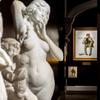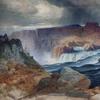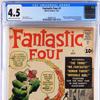The Unexpected Paintings of Frank Sinatra
- August 07, 2020 13:37

Ol’ Blue Eyes. The Sultan of Swoon. The Chairman of the Board. The great Frank Sinatra was a man of many talents and went by many names. Few, however, know that he could also claim the title of “painter.” When he wasn’t recording chart-topping hits or starring alongside Marlon Brando and Grace Kelly, Sinatra turned to painting. There is passion and earnestness in his works that is somewhat unexpected, but at the same time not entirely surprising. He attacked the canvas with the same fervor as the rest of his ambitions, and the result is a body of work that feels highly personal. M.S. Rau is pleased to offer a number of works from the famous crooner, each more wonderful than the last.
Sinatra was a man who was passionate about art his entire life, and after rising to fame, he became a highly important collector of modern art. Joan Miró, Pablo Picasso, Marc Chagall, Leroy Neiman, Walt Kuhn and Childe Hassam were among the many artist represented in a diverse group of works in the Sinatra collection; the singer’s artistic preferences ran the gamut from Impressionism and Cubism to Abstraction and Minimalism. He also bought several works from another singer-cum-painter: Tony Bennett.

Many of Sinatra’s own canvases take their inspiration from his favorite artists. He composed a drip painting à la Jackson Pollock (though on a far smaller scale), a number of clown paintings inspired by Walter Kuhn and a grid painting in primary colors that could be mistaken for a Mondrian at first glance. While his paintings do vary dramatically in style, many of them tend towards the abstract, rendered in brilliant colors with geometric shapes.
Sinatra’s wife Barbara observed him at work and once said of his process, “He was, of course, Charlie Neat when it came to painting; there was rarely any mess. He only ever had one ‘Jackson Pollock moment’ that I knew of. I walked into his studio one day and found him reaching into pots of paint with his fingers and hurling it at the canvas. I don’t think he even knew I was there. Watching him lost in a world of his own creativity, I knew that art was another kind of therapy for him."
Like many famous individuals who painted as a hobby (Winston Churchill comes immediately to mind), Sinatra’s approach to painting was one of pure pleasure. He was less concerned with making an artistic statement or pushing boundaries, and more with putting paint to canvas for the mere delight of it. Many of his works were completed in the 1980s and ‘90s at Rancho Mirage, the Palm Springs estate where Frank and Barbara spent most of their marriage. His works were never offered for sale, but rather hung on the walls of their home or were given to dear friends like the Reagans.
Because Sinatra painted for himself, there is a charming lack of finish to many of his works. Lines are rarely perfectly straight, colors bleed into one another, shapes are slightly misshapen. Above all Sinatra’s works are human. They show us a man who is doing something he loves entirely for himself, emulating the artists that he most admires. And he does it all with the same sense of confidence and style that he always brought to the rest of his career.

Regrettably, Sinatra stopped painting a few years before his death. Not only had he developed problems with his vision, but he also feel into a deep grief following the death of his friend and fellow entertainer, Jilly Rizzo. The singer tragically died in a car accident in 1992 on his 75th birthday. Tony Oppedisano, a mutual friend of Sinatra and Rizzo, said that he never saw Sinatra pick up a paintbrush again after that.
To view the works of Frank Sinatra in M.S. Rau’s collection, please click here.
About M.S. Rau:
M.S. Rau has spent more than 100 years earning the trust of discerning collectors worldwide. Located in the heart of New Orleans’ historic French Quarter, our peerless showroom houses one of the world’s most extensive and stunning collections of museum-quality fine art by artists such as Claude Monet and William Bouguereau, 18th- and 19th-century antiques and breathtaking jewelry, including rare colored diamonds.





















